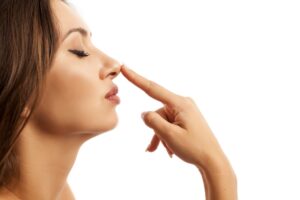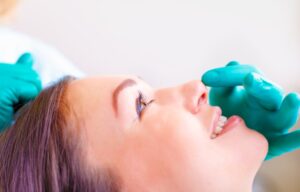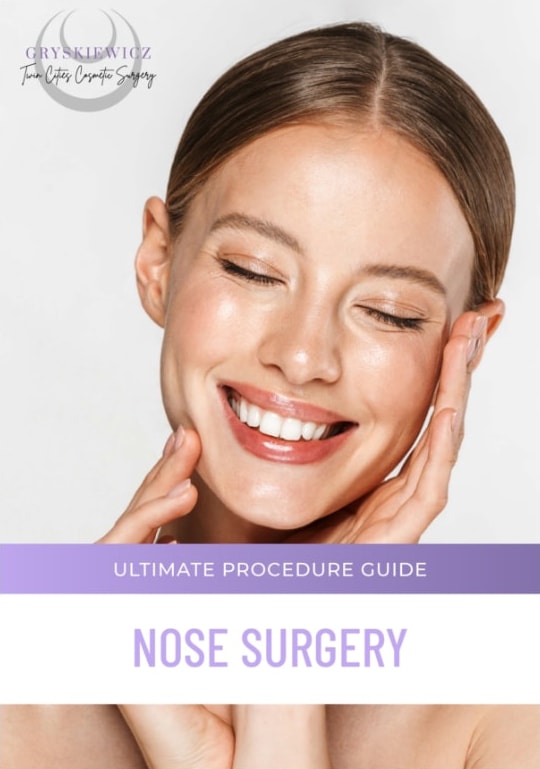How to Make Your Nose Smaller – Surgery for a Smaller Nose
Written By Joe Gryskiewicz, MD, FACS
The shape and size of your nose can determine how your face looks. While some people find a pronounced and large nose beautiful and interesting, others try to hide this facial feature with makeup or hairstyles that make their nose appear smaller. If you don’t like the look of your nose, find out how to make your nose smaller with the help of plastic surgery.
Minnesota Plastic Surgeon Dr Joe Gryskiewicz is a nose surgery expert and can help you get the nose you want by performing rhinoplasty surgery.
What Surgical Options Are Available to Reduce the Size of Your Nose?
If you think your nose needs to be worked on by a plastic surgeon, you can opt for different types of rhinoplasties. You can either have a reduction in the size of the base of your nose, a tip rhinoplasty or you could have nose reshaping rhinoplasty.
If you have a small chin, your surgeon might talk to you about the possibility of chin augmentation. A small chin gives the impression of a larger nose. In some cases, chin surgery is unnecessary, although it may help better balance your facial profile.
What Is a Rhinoplasty?
 A rhinoplasty is a type of plastic surgery that changes the size or shape of the nose. Since the nose is your face’s focal point, any small change that affects your nose has a big impact.
A rhinoplasty is a type of plastic surgery that changes the size or shape of the nose. Since the nose is your face’s focal point, any small change that affects your nose has a big impact.
Rhinoplasty is one of the most common plastic surgeries can change your nose’s cartilage, bone, or skin. Before you have this procedure done on your nose, you should talk to your plastic surgeon about how you want your nose to look and whether you should undergo rhinoplasty.
Rhinoplasty is one of the most challenging and complex cosmetic procedures that can change your appearance and can also affect your ability to breathe. So make sure to find the best surgeon for your procedure.
Before performing either type of rhinoplasty on you, your surgeon will analyze the other features of your face, the skin of your nose, and the changes you want to achieve. Now, let us look at how the types of rhinoplasties can help you reduce the size of your nose.
Base Reduction Rhinoplasty to Make Your Nose Smaller
A nasal base reduction, or alarplasty, involves reshaping the nostrils to create a smaller nose. After the surgeon removes the tissue, he will suture the skin of your nose to make the base of your nose narrower.
Fortunately, the natural folds of your nose can easily hide the scars of an alarplasty. In addition, this procedure reduces the size and width of the nostrils.
What To Expect During Alarplasty Surgery
Alarplasty is a stand-alone procedure and is less invasive than a full rhinoplasty. The plastic surgeon usually takes less than 60 minutes to perform the procedure, and you will most likely need local anesthesia.
If your surgeon is to perform other procedures on your face, you will most likely have a general anesthesia. The type of anesthesia depends entirely on what you want and how complex the procedure is.
Before the procedure, your surgeon will provide you with more details to ensure you are comfortable with what follows.
Recovery after Alarplasty
Because alarplasty does not require bone reshaping, you should expect a quicker recovery than after a traditional rhinoplasty.
A few days after the procedure, you might feel discomfort and swelling in the nose area. You should also expect some bleeding 2 days after the procedure. After a week, the swelling should be gone.
Your surgeon might prescribe analgesic medication to help alleviate the pain and discomfort. The healing process after alarplasty involves caring for your new nose and nostrils, even after the surgeon removes the sutures.
Nose Reshaping Rhinoplasty to Reduce the Size of Your Nose
 Nose reshaping rhinoplasty is the type of surgery often referred to as a “nose job.” The goal of this procedure is to contour your nose so you can be happy with the size and shape of your nose.
Nose reshaping rhinoplasty is the type of surgery often referred to as a “nose job.” The goal of this procedure is to contour your nose so you can be happy with the size and shape of your nose.
In an open rhinoplasty, your surgeon makes an incision through the skin between your nostrils. In a closed rhinoplasty, the surgeon makes incisions inside your nostrils.
Most people prefer closed rhinoplasty because it causes less swelling and leaves less visible scarring.
What to Expect During the Nose Reshaping Rhinoplasty Surgery
It usually takes a plastic surgeon 1.5 to 3 hours to perform a rhinoplasty. Your surgeon may use a scalpel to remove excess cartilage and an osteotome to shape the bone.
During the procedure, your surgeon might also work on your nasal airway to improve your breathing. Therefore, rhinoplasty can be more than just plastic surgery for some people.
Depending on your surgeon’s preference and your procedure’s complexity, you may receive either local or general anesthesia.
Recovery after Rhinoplasty
You will recover from rhinoplasty in around 2 weeks. However, you will also need to wait a month or more to see the effects of the procedure.
Most of the swelling will go down after about 6 weeks. Some swelling may persist for up to a year. Your surgeon will remove the stitches after one week. On the other hand, dissolvable stitches disappear on their own.
You will have a splint on your nose to protect it for one week. Then you may be started on a compression exercise and night taping program.
Swelling, discomfort, tenderness, and bruising on your cheeks may bother you for a week after your procedure. However, everything will have healed in 2 weeks.
After the procedure, your surgeon will give you detailed and specific instructions. You will learn how to take care of your nose, what medications to take, and what to avoid.
Preparing for Rhinoplasty Surgery
 Before you make an appointment for surgery, you will need to discuss with your plastic surgeon whether a rhinoplasty is right for you. This conversation often involves the following topics:
Before you make an appointment for surgery, you will need to discuss with your plastic surgeon whether a rhinoplasty is right for you. This conversation often involves the following topics:
- Your medical background. Your surgeon will ask you about your reasons for surgery and goals. Your surgeon will also ask about your medical history, including any surgeries, nasal obstructions, and medications you take. For example, you may not be a candidate for rhinoplasty if you have a blood problem. One such problem could be hemophilia
- Photographs of your nose. Your surgeon will take many photographs of your nose from different angles. They may use computer software to alter the photographs to show possible results. Plastic surgeons use these images for long-term evaluations, before-and-after comparisons, and surgical reference. Most importantly, the photos provide a detailed explanation of the surgical goals
- Medical exam. Your surgeon will examine the inside and outside of your nose and your facial features. The physical exam will help your surgeon determine what changes are needed. They will also analyze how physical features such as skin thickness or the durability of the cartilage at the tip of your nose may affect the results. In addition, the physical exam results will determine how rhinoplasty affects your breathing
- A conversation about your hopes. It would help if you discussed your goals and expectations with your surgeon. Your plastic surgeon will discuss what rhinoplasty can and cannot do for you and the possible outcomes. It is normal to be unsure about your appearance. Still, don’t forget that you need to be honest with your surgeon about your desires and surgical goals if you want the best results
If you are undergoing outpatient surgery, you must have a plan for transportation after your scheduled procedure. Moreover, you will feel a certain level of discomfort in your face.
Benefits of Rhinoplasty
Over 200,000 rhinoplasties are performed annually, making it one of the most common cosmetic surgical procedures.
Although many people have a rhinoplasty primarily for cosmetic reasons, you may be surprised at the health benefits of this procedure. For many people, rhinoplasty boosts their self-esteem, but it can also positively affect their overall health.
Here are some of the benefits of rhinoplasty for you:
- Increased self-confidence: increased overall quality of life is perhaps the most significant positive effect of rhinoplasty. After rhinoplasty, men and women often find that their self-confidence and self-image have improved significantly, and they can breathe and sleep better. This improved self-esteem can contribute to more fulfilling relationships, a more stimulating social life, and greater success at work
- Improved respiration: your respiratory problems may have several causes. A deviated septum, which is essentially an asymmetry between the two inner chambers of the bridge of the nose, is one of the most typical. Choose a surgeon with extensive experience in treating people with a deviated septum to help them breathe more freely. It can lead to a better quality of life and make participating in sports and other physical activities more manageable
- Better sleep: people often sleep better after a rhinoplasty because breathing improves. With rhinoplasty, conditions such as sleep apnea and symptoms such as snoring often get resolved, allowing you to sleep soundly and undisturbed once again. Besides, you would no longer bother your loved ones with your loud snoring
- Changing the size of your nose: in many cases, rhinoplasty, also known as a nose job, is performed to change the size of the nose to fit your face better
- Changing the size of your nostrils: rhinoplasty can be a good solution for people who feel that their nostrils are too small, too narrow, or asymmetrical
- Correcting nasal symmetry: an asymmetrical nose is typical among people considering rhinoplasty. It can result from an injury, a congenital abnormality, or even a poorly performed rhinoplasty in the past
- Additional desirable facial features: rhinoplasty can also correct other cosmetic flaws. A bulge on the bridge of the nose worries many people. This issue is common among people of certain ethnicities. In these cases, plastic surgeons offer ethnic rhinoplasty as an individualized treatment option. This specialized procedure addresses the unique structural aspects of the nose while preserving your natural features and addressing their concerns. An upturned nasal tip and a hook at the end of the nose are other features that can improve with rhinoplasty
FAQs about How to Make Your Nose Smaller and Rhinoplasty Surgery
-
How do I know if I am a good candidate for rhinoplasty?
If you do not like the size or shape of your nose or are having trouble breathing, you should consider talking to a plastic surgeon and ask if you are a good candidate for rhinoplasty. You are a good candidate if your health is fine, you do not smoke, and you want to make a difference in the appearance of your nose.
-
How long will I have to stay in the hospital after a rhinoplasty?
Almost all people who undergo rhinoplasty can leave the hospital the day of surgery. However, you may need to stay in the hospital for one night if you suffer from nausea or have other health problems that require close monitoring.
-
How long before I can return to my routine after a rhinoplasty?
It varies from person to person, but most people can resume regular activities and work after about 8-10 days. People with physically demanding jobs may need more time to heal before they can continue work. It might take a while before starting to exercise again as well.
Further Reading about Face Procedures at Twin Cities Cosmetic Surgery, Minnesota
- Facelift Surgery page
- Injectables page
- Facial Liposuction Procedure page
- Blepharoplasty Surgery page
- Rhinoplasty Gallery page



